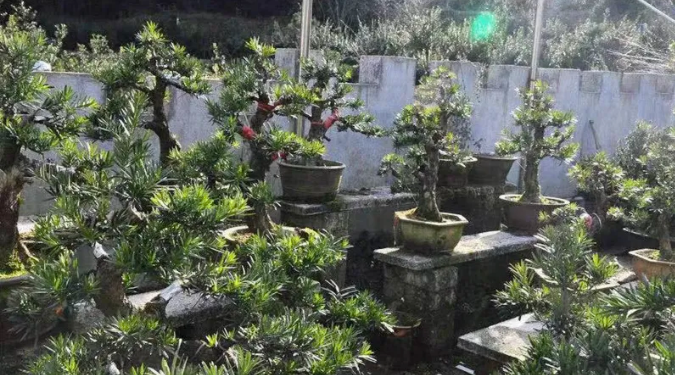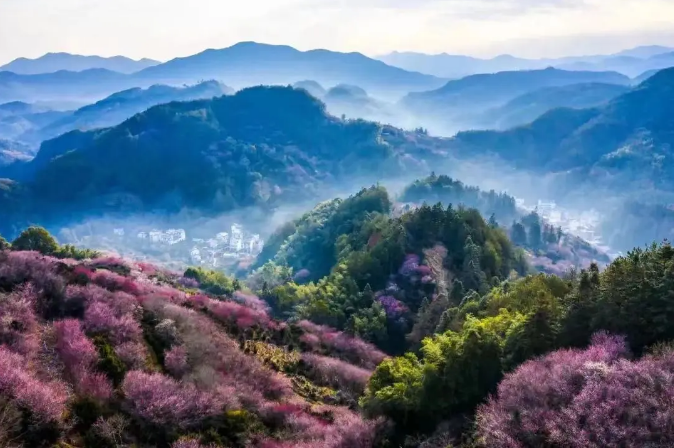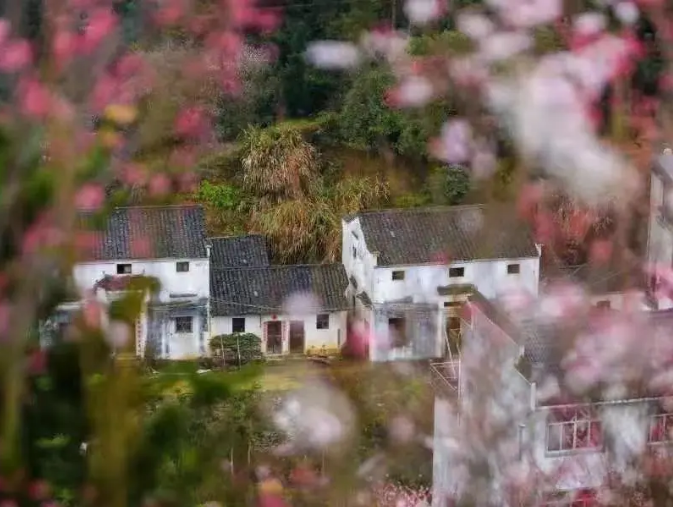


Walking into Maihuayu Village, Shexian County, Anhui Province, China, visitors are greeted with charming and graceful architectural structures that connect harmoniously with the surrounding natural landscape. The mountains, water, flowers, trees, and ancient buildings collectively create a captivating scenery in the village.
Nestled along the southern bank of the Xin'an River in Shexian County, Maihuayu Village presents a striking sight resembling a fish when viewed from above. Its layout artfully mirrors the elegant contours of a fish, featuring a pointed head reminiscent of a fish's mouth, a broad midsection akin to its belly, and houses spreading out from its lower part, resembling the fish tail. Inspired by their aspiration for a tranquil and carefree life like a duck to water, the villagers fittingly christen the village "Maihuayu" , meaning "flower-selling fishing village" .
Local villagers frequently utter the saying "In the village, we don't fish; we simply sell flowers" , encapsulating the "happiness code" of this ancient village. Renowned as the birthplace of Huizhou-style bonsai, the majestic peaks of Mount Huangshan offer an ideal environment for nurturing bonsai plants and tree stumps. For millennia, the villagers of Maihuayu have sustained themselves by growing bonsai and selling flowers. In 2022, the village achieved a remarkable milestone with total bonsai sales surpassing 26 million yuan.
The "prosperity flowers" bloom in small courtyards
The village's development is rooted in the Huizhou-style bonsai. Meandering through the cobblestone paths in the mountainous countryside, visitors are greeted by an assortment of bonsai in various shapes adorning every corner. These bonsai not only boast exceptional ornamental allure but also encapsulate the legacy of generations of craftsmanship and the distinct cultural heritage of its own.
Hong Dingyong, former secretary of the Village Party Committee and president of the Huizhou-style Bonsai Association of Shexian County, told reporter that bonsai cultivation in the village dates back to the Tang Dynasty. For over 1,300 years, villagers have been nurturing Huizhou-style bonsai, rendering the village the inaugural hub in China.
Hong Dingyong highlighted that in Maihuayu Village, every household boasts an exhibition of flowers, trees, and bonsai, with each home being tended to by a bonsai master. Whether nestled in front or behind the house, or adorning the interiors and exteriors of courtyards, these intricately crafted bonsai enhance the scenery with vibrant greenery, deeply intertwining with the beauty of the mountains, valleys, and streams. Across generations, the villagers who have resided in this locale have witnessed the splendid transformation of their village.
"A yearly income of several hundred thousand yuan is definitely achievable! " said villager Hong Shunguang with unwavering confidence as he stood before his courtyard gate. Behind him stands a four-story Huizhou-style building. "This is the house I built with over 900,000 yuan earned from selling bonsai four years ago, " proudly said Hong Shunguang.

Hong Shunguang, a bonsai expert in the village, meticulously tends to a magnificent collection of over two hundred Huizhou-style bonsai in his courtyard, each is a testament to his exceptional care and skill. "Take this one in the shape of podocarpus macrophyllus, for instance, " pointed out Hong Shunguang, gesturing towards a particular bonsai, "its shape is modeled after the renowned Welcoming Pine in Mount Huangshan. Its market value is at least over 100,000 yuan. "
To bolster Maihuayu Village's "courtyard economy" , the local government has made significant investments in infrastructure. This includes the expansion and construction of roads leading into the village. In 2006, the completion of a key road linking the village to the outside world opened up opportunities for business. Trucks loaded with bonsai drove to various parts of the country. "Most of the bonsai are sold at our mountainside doorstep, and most of the buyers opt to visit in person to make deals, " said villager Hong Jixiang to reporter.
Currently, the total land area of Maihuayu Village is 3,800 mu (around 626 acres), with over 2,000 mu (around 330 acres) of mountain fields for planting bonsai seedlings. Every year, over 60,000 pots of sculpted bonsai are available for sale. Xu Yulong, head of the village work team said, "For villagers, they are able to earn more money right at their doorstep, with bountiful harvests all year round. "
From selling bonsai to selling village scenery
Bonsai has not only elevated the scenic charm of the village but has also fostered a thriving "beautiful economy" . Annually, before and after the Spring Festival, the plum blossoms in Maihuayu Village burst into vibrant bloom, creating a mesmerizing spectacle. The mountains are adorned with competing clusters of plum blossoms, complementing the traditional white-walled, black-tiled houses. This breathtaking display draws tourists from across the nation, who flock to the village to revel in its picturesque spring scenery.
"This year marks the 11th 'Plum Blossoms Festival' , and the turnout is so immense that the village is bursting at the seams. In just that one month, we can rake in about 100,000 yuan," said Zhang Lixian, a local villager who runs a homestay in the village. Benefiting from the bonsai and flower-viewing economy, Zhang's homestay has flourished, now boasting 34 beds. "We can earn about 200,000 yuan a year from selling bonsai and running homestay. We couldn't be happier, " Zhang added, beaming with satisfaction.

Relying on Huizhou-style bonsai industry and unique natural scenery, Maihuayu Village has extended the bonsai industry chain through tourism. This strategic initiative harnesses the intangible cultural heritage of bonsai as a pivotal driver for increasing villagers' income, broadening rural employment opportunities, and fostering the collective economy of the village. In doing so, the village embarks on a path of rural revitalization featuring sustainability, prosperity, and tourism.
This year, Maihuayu Village has achieved record-breaking numbers in both tourist arrivals and collective income. The village welcomed an impressive 160,000 tourists who came to enjoy the flowers, contributing to a collective operating income of 1.76 million yuan. The "Plum Blossoms Festival" plays a pivotal role in driving local income from various sources, including bonsai sales, agritainment, homestays, and more, reaching a remarkable total of 6 million yuan.
Passing on the torch, revitalizing the exquisite tradition
The villagers often echo the sentiment that grandfather plants the flowers, grandson sells them, underscoring the enduring patience intrinsic to the art of Huizhou-style bonsai. This tradition recognizes that bonsai cultivation spans generations; whenever one is uprooted, two or more must be planted. Upholding this legacy, the bonsai industry in the village has thrived for millennia. Currently, the village has gathered a skilled team of 86 individuals, bringing together the wisdom and expertise of the elderly, middle-aged, and youth in the craft of Huizhou-style bonsai.
Many young people have responded to the village's call to return home and join the bonsai industry, including Hong Yu, a post-90s girl. In 2018, Hong Yu quit her teaching job and returned to help her family with online sales. Upon returning to the village, her first priority was to establish an e-commerce platform. Through live streaming videos, she shares the art of Huizhou-style bonsai with a broader audience. "We now have over 20,000 followers, and each live session attracts around 10,000 viewers," she proudly proclaimed.
To cater to the preferences of today's market and appeal to the aesthetics of young consumers, Hong Yu apprenticed herself and learned the craft. She collaborated closely with traditional craftsmen to inherit and refine the techniques of Huizhou-style bonsai. Together, they crafted a series of miniature bonsai suitable for placement on desks or coffee tables, which have garnered significant favor among young buyers. "We're witnessing a growing proportion of young people in our consumer base, " Hong Yu noted. "During peak seasons, we can make sales of one to two hundred thousand yuan in just one or two hours of live streaming," said Hong Yu.

Today, nearly 20 young villagers, around the same age as Hong Yu, have opted to stay in the village, united by a shared objective: to preserve and advance the traditional craftsmanship of Huizhou-style bonsai.
Through the bonsai industry, the ancient village, with its millennia-long history, has experienced a resurgence marked by inheritance, development, innovation, and shared prosperity. It has indeed revitalized the landscape, turning its clear waters and green mountains into mountains of gold and silver. The "miracle" of the harvest planted by the Maihuayu Village will continue.
(图片来源于网络)

服务邮箱:agricn@126.com 违法和不良信息举报电话:010-84395205
京公网安备 11010502040354号 互联网新闻信息服务许可证10120170078 京ICP证05068373号
农民日报社主办,中国农网版权所有,未经书面授权,禁止使用
Copyright©2019-2024 by farmer.com.cn. All Rights Reserved